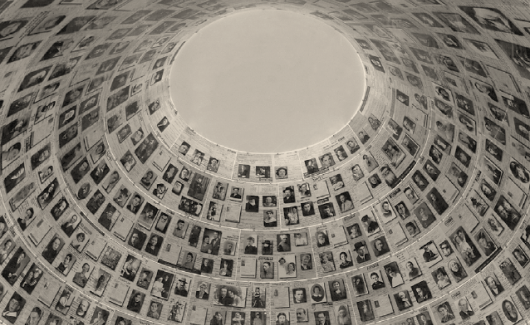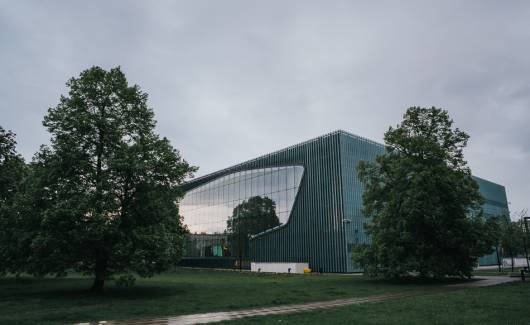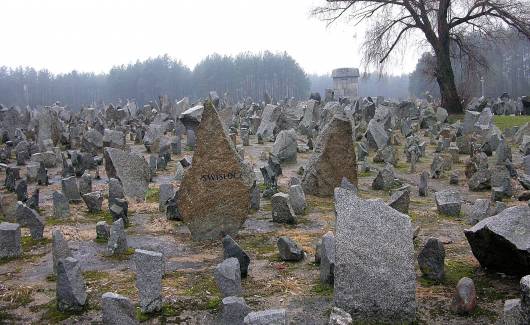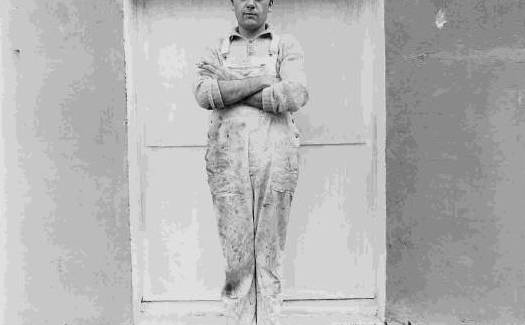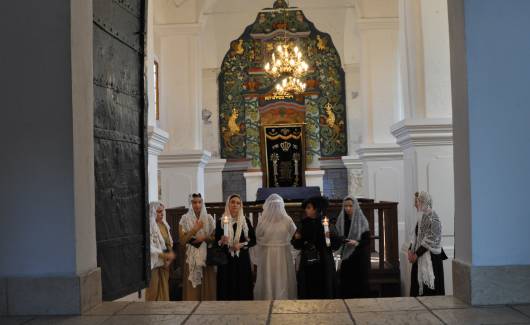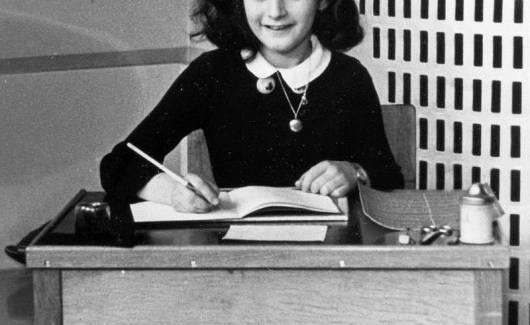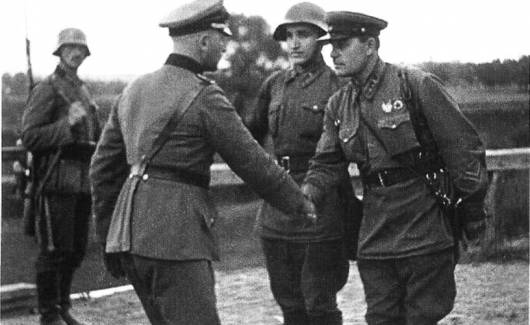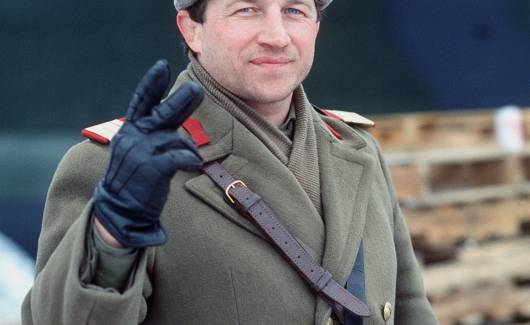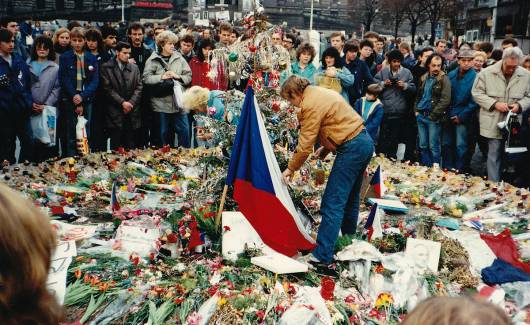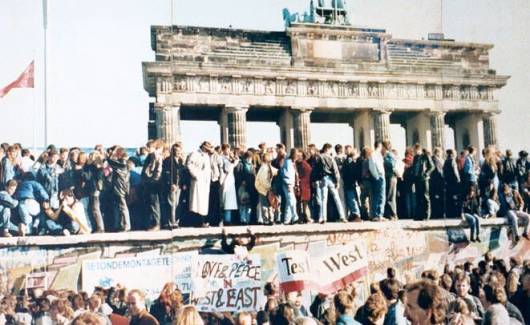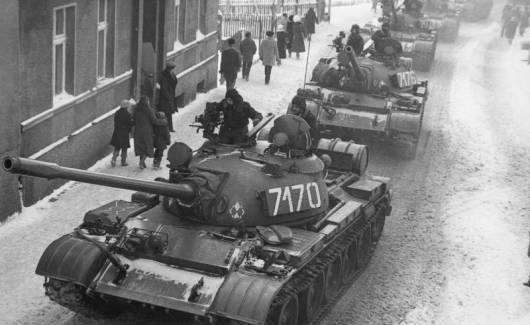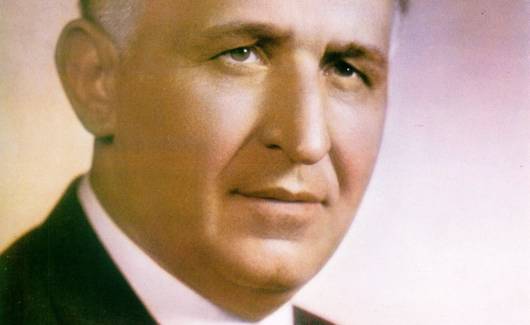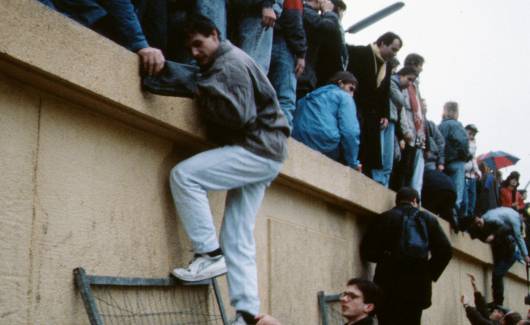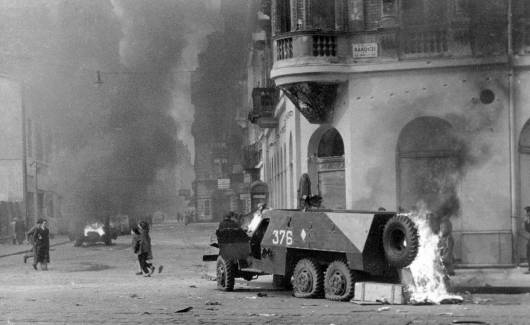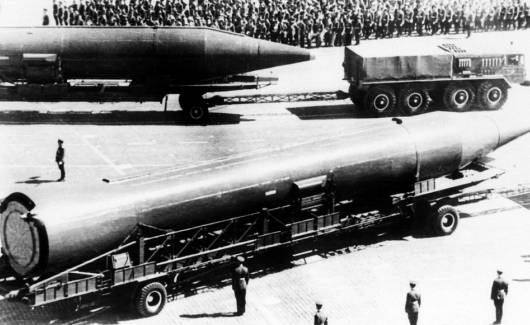ABSTRACT
The positioning of the Holocaust in post-war European memory was set by two strategies: suppression, externalization and the projection of blame on Germany in countries occupied by Nazi Germany and collaborating regimes and of a comparison with other crimes in the form of totalitarianism or fascist theory as a transnational-European argument in the era of the Cold War. Recognition of the Holocaust as a singular ‘break with civilization’ that took hold at the end of the 20th century in Europe and in Western societies presupposed the incomparability of the Nazi murder of Jews. With the enlargement of the European Union (EU) in 2004, which included former Eastern Bloc countries, came the challenge of integrating communist crimes in a common European memory – this entailed the renewed discussion of the issue of comparability.
Introduction
At the start of the new millennium, Europe seemed united by a common memory. The historical and political myths of post-war Europe lost their binding force in the 1980s. This was a phase of intensive redefinition of national views of history, which were intensively redefined and gained additional momentum with the end of the Cold War and the epochal year of 1989. In the memory wars of the late 20th century, the Holocaust also became a central historical reference point at the national and – with the intensification of EU integration – at the European level. ‘Already the catastrophe in Europe is a starting point for cross-border solidarity,’ stated sociologists Daniel Levy and Natan Sznaider in 2001 in their highly noted publication Erinnerung im globalen Zeitalter: Der Holocaust [Recollection in the global age: the Holocaust] that is based on the hope for a universal human rights morality no longer bound to a ‘we’ community of a nation: ‘Memories of the Holocaust allow the formation of supra-national cultures of memory at the start of the third millennium, which, in turn, are the basis for a global human rights policy’ (Levy and Sznaider 2007, 11). A key event for universalization of the Holocaust was the Stockholm International Forum on the Holocaust with the adoption of the Stockholm Declaration in January 2000 (Eckel and Moisel, 9 f.; Radonić and Uhl 2016, 10 f.).
This European remembrance consensus, however, would soon face new challenges. With the accession of eight countries of the former Eastern Bloc to the European Union in 2004, the question of the relationship between the crimes of National Socialism and communism appeared on the agenda EU-European policy on history and remembrance culture. The Gulag memory 1 of post-communist European countries now competed with the Holocaust memory and the issue of the relationship between these competing memories has since dominated debates on European memory. Thus, the assumed singularity of the Holocaust was called into question. Several years after the political codification of the Holocaust as a singular crime against humanity in the Stockholm Declaration, a discussion on comparison was back on the agenda.
The historical comparison, as a central category of historical academic insight, 2 had, however, lost its innocence in relation to the Holocaust. Each comparative effort reactivated the post-war defensive tradition by equating it with other state crimes. The intentions of comparison in Germany and Austria lay in a relativity of its ‘own crimes’ by pointing to its ‘own suffering’, which had been inflicted on ‘us’. During the Cold War, expulsion and bombing were arguments that entitled the Federal Republic of Germany to its own victim status (Kettenacker 2003).
Now, under the new aegis of integration, the question of a comparison with the communist dictatorship experience in a common European memory was revived. The result of the struggle for recognition of the Holocaust as a European place of memory and the prevailing belief in the late 20th century that the murder of the Jews was a singular historical crime had to be legitimized and justified anew after 2004 given its equation with the crimes of communism. This challenge marks current debates about the universalization and relativization of the Holocaust.
Stockholm 2000: codification of the Holocaust as a singular ‘break with civilization’
From 26 to 28 January 2000, around 600 delegates from forty-six countries, including more than twenty heads of state, gathered at the Stockholm International Forum on the Holocaust, one of the first high-level international conferences of the new millennium. The symbolic date of the anniversary of the liberation of the Auschwitz-Birkenau concentration and extermination camp had only been assigned as a memorial day several years earlier (Kroh 2008, 111 f., 128 f.). 3 The Holocaust as a singular historical event and reference point for a European and potentially global culture of memory was first recognized at a senior political level at this conference. In the Stockholm Declaration, a final document based on the model of UN World Conferences, this commitment was not only morally, but also politically codified:
The Holocaust (Shoah) rocked civilization to its foundations. The unprecedented character of the Holocaust will for all time be of universal significance. [...] The extent of the Holocaust planned and executed by the Nazis must remain forever enshrined in our collective memory. [...] Since mankind is still marked by genocide, ethnic cleansing, racism, anti-Semitism and xenophobia, the international community shares a solemn responsibility to fight these evils. [...] It is entirely appropriate that this first major international conference of the new millennium declare its commitment to plant the seeds of a better future in the soil of a bitter past. 4
The International Task Force for Holocaust Education, Remembrance and Research (ITF, renamed International Holocaust Remembrance Alliance [IHRA] in 2012) that was founded during one of the precursor meetings of the Stockholm conference in 1998 was to be the body to apply these principles. One of the entry criteria for the thirty-one member states is a commitment to the Stockholm Declaration and the establishment of a Holocaust Memorial Day. 5
The road to Stockholm: the end of the great narratives of modernity and memory wars at the end of the 20th century
The Stockholm Declaration is a result of a social and cultural transformation process in the 1980s that ties two strands of development: recognition of the Holocaust as a singular ‘break with civilization’ – this term was coined in 1988 by historian Dan Diner (Diner 1988) – and memory as a leitmotif of the late 20th century. French historian Pierre Nora, one of the pioneers of the memory boom, spoke at the Vienna conference ‘Memory of the Century’ in March 2001 of a ‘global conjuncture of memory’. 6 The ‘era of remembrance’ is supported by a ‘movement’ that is ‘so general, so profound, so powerful’ that it entails a fundamental change in the collective consciousness. 7
The factors for this profound social and cultural change are manifold. Paramount is the loss of key categories and thought patterns that had previously determined the self-understanding of modern societies: the ‘dwindling meaningful strength of the nation’, 8 ‘the end of grand narratives’ about rise and progress, 9 and depletion of a vision of the future. Optimistic expectations of progress focused on the future in the post-war decades. Now, the ‘utopian energies’ of modernity were beginning to erode (Habermas 1985, 141–63), the ideological guiding differences that dominated the political imagination since the 19th century and structured areas of social conflict began to fade. The end of the Cold War and of the competition between the two totalitarian systems – Nazism and communism – with their clear bogeymen accelerated the perception of a new era. ‘Since the 1980s, it seems that the focus has shifted from present futures to present pasts,’ stated literary scholar Andreas Huyssen, who spoke of a cultural and social change requiring explanation:
One of the most surprising cultural and political phenomena in recent years has been the emergence of memory as a key concern in Western societies, a turning toward the past that stands in strong contrast to the privileging of the future so characteristic of earlier decades of 20th century modernity (Huyssen 2000, 21).
In the post-modern, post-utopian, neo-liberal and globalizing world, the past has been a resource for meaning and the search for identity. The need for commemoration could no longer be fulfilled by the traditional narrative of a glorious and heroic history of the nation in a post-ideological and post-national era.
The official narratives of time before 1945, on which the historical identity of European countries based itself since the end of the Second World War, were in exactly this tradition. The national self-presentations also varied according to their different involvement in the Nazi regime. They are seen as variants of a reasoning pattern that historian Tony Judt – in the hot phase of historical-political debate in 1992 – called post-war Europe political myths.
He characterized them as follows: after 1945, the official historical narrative about the recent past in practically all European countries, even communist (naturally with the exception of West Germany), was marked by an exclusion of historical guilt that remained fairly stable until the 1980s. The intent was to present their ‘own people’ as an innocent victim of cruel suppression by a hostile external aggressor, to honour heroic national resistance and to hide issues of collaboration. With a retrospective construction of a society that was not involved in Nazism, these narratives fulfilled the function after 1945, which should not be underestimated, of overcoming civil war situations during the Second World War and of integrating societies deeply divided politically during Nazi rule (Judt 1993, 87–120). However, this was only possible by concealing the involvement of parts of their own society in the conduct of the regime and in Nazi crimes.
The thesis of Austria as the ‘first victim’ of Nazism was only one, albeit probably the weakest legitimate variation in the range of European postwar myths, because Austria after it was annexed to Nazi Germany (the socalled ‘Anschluss’) in March 1938 was not an occupied country, but a genuine component of the German Reich. 1011 Jewish victims of the Nazi extermination policy only played a minor role in the heroic master narrative of post-war myths. The question of guilt and responsibility was projected onto Germany, or the Federal Republic, while the murder of Jews was not brought to the fore. The memory of the victims of ‘racial’ persecution was particular, mostly confined to Jewish communities. They launched the first initiatives for memorials, which, compared to the monumental projects for memorials to national resistance, hardly received any public attention. In Vienna, a simple plaque donated by the Jewish community was mounted in 1946 in the vestibule of a synagogue on a side street of the first district – the only synagogue that was not destroyed in the November pogrom. It commemorated the ‘Jewish men, women and children who lost their lives in the fateful years 1938–1945’ (Uhl 2016, 3–4).
The status of victim found no recognition in the narratives of the struggle for freedom against Nazism in post-1945 Europe. Jewish survivors were even admonished for not actively taking part in the ‘anti-fascist struggle’. This was the proclamation of the Austrian Concentration Camp Association on the tenth anniversary of the liberation in 1955 under the motto: ‘to be human – is to be anti-fascist’. According to a post in Der neue Mahnruf, the journal of the Communist Party, close to the association: ‘The vast majority of victims were not active political opponents of fascism. How many of the millions of people murdered in the gas chambers of Auschwitz were there, who probably regretted their tragic error in the last agonising minutes of life [...]?’ 12
Numerous studies have focused in recent years on the question of how the Holocaust returned from the periphery of historical perception – as a sideshow of the Second World War and as a part of the history of Nazi Germany – to the centre of a global memory. The murder of Jews did not play a primary role at the Nuremberg trials of German war crimes and crimes against humanity. Milestones of a change in perspective were the Eichmann trial in 1961 13 and the West German Frankfurt Auschwitz trial in the 1960s. 14 Awareness of the meaning of the Holocaust increased only gradually, 15 as shown by the reception of historian Raul Hilberg’s pioneering book The Destruction of the European Jews (1961). After completing the manuscript, it took six years until a small publisher in the United States agreed in 1961 to publish the study. In 1967, the Rowohlt editor Fritz J. Raddatz refused a German edition because of an already ‘heavy burden from non-fiction [...]’ (Aly 2006).
An actual turning point was the broadcasting of the NBC miniseries ‘Holocaust’ in the United States in 1978 and in the Federal Republic of Germany and Austria in 1979. The first transnational popular key cultural event 16 was followed by intensive reporting – the news magazines Der Spiegel (Germany) and Profil (Austria) each issued a sequence of three cover stories. Previously distanced terms like ‘final solution’ for the murder of Jews now received a name in which a new emotional dimension resonated. The overwhelming response to the ‘Holocaust’ in Germany and Austria demonstrated new memory needs that obviously could not be fulfilled by the heroic pathos of post-war myths. ‘Holocaust’ led to empathy for the fate of the victims to a royal moral imperative: the obligation to remember the victims (Margalit 2004). The paradigm shift from a heroic to a victim narrative would prevail in the 1980s. 17 Attention shifted from the now perceived formulaic rhetorical representations of patriotic or ideological anti-fascist motivated resistance to the harrowing testimonies of Holocaust survivors. Central historiographical and literary works were only now appreciated as important. Raul Hilberg’s The Destruction of the European Jews, a complete history of the Holocaust, was published in a German translation in 1982 by the small publishing house Olle & Wolter and in 1990 as a Fischer paperback (Hilberg 2008). Imre Kertesz’s Fateless, published in Budapest in 1975 after an initial rejection, only found recognition in a new edition in 1985 and appeared in German translation in 1990.
The fall of the Iron Curtain ended the threat of the communist Eastern Bloc, the source of evil during the Cold War, and the fear of a nuclear Third World War. These thoughts dominated the collective imagination of the West into the 1980s, as shown in the film The Day After (1983) in which an incident in Berlin triggers a nuclear war with catastrophic consequences. The elimination of competition of the two totalitarian systems and, therefore, the ultimate ‘other’ that threatened Western democracies, and at the same time defined it, left a vacancy. Against this background developed the ‘incredible phenomenon’ that the Shoah ‘became a symbol of evil in [...] Western civilization in the last two decades of the 20th century’ (Bauer 2001, 10). A key stimulus for the re-evaluation of the Holocaust as a singular crime against humanity was generated by the founding of the United States Holocaust Memorial Museum in Washington, DC, which was initiated by President Carter in 1978. 18
At the start of the 21st century, the Holocaust gained broad recognition as ‘negative remembrance’ (François 2006, 295) with European and global relevance. This new understanding falls within the term ‘Auschwitz’s break with civilization’ expressed as follows: the Holocaust is not only a landmark of German and European history, but is also the deepest cut in the history of modernity, as it symbolizes the radical other in human and civil rights, the fight against racism, anti-Semitism and xenophobia-based values . In 2005, Tony Judt assessed the importance of this historical foundation for contemporary Europe. ‘Recognition of the Holocaust has become a European entry ticket’, 19
and the European project was built ‘from the crematoria of Auschwitz’ (Judt 1993, 934).
This paradigm shift is, as historians Jan Eckel and Claudia Moisel stress, ‘as astonishing as in need of explanation’. The ‘profound change of the traditional relationship with the past’ 20 was not triggered by a political turning point, but rather it was a simultaneous generational phenomenon that ensued in countries with such a different relationship to the murder of the Jews as the ‘perpetrator societies’ of Germany and Austria, the ‘victim country’ Israel and the ‘liberator’ USA. In addition to the previously mentioned global phenomena, other explanatory factors worthy of mention are the end of the Cold War and East–West confrontation and system competition, along with the loss of the belief in progress and a better future. In Germany and Austria, it can be assumed the question of involvement in crimes of the Nazi regime could take a new form with the ageing and demise of the affected generation, especially those who actively took part in the crimes. As the new generation were not directly influenced by National Socialism, this augured well for change. 21
The radical nature and pace of the break with those official narratives and political myths that determined historical thought in these two countries since 1945 is nevertheless remarkable. In 1983, on the occasion of the 50th anniversary of the Nazi seizure of power on 30 January 1933, the conservative historian Herrmann Lübbe defended the silence – the ‘asymmetrical discretion’ – regarding the Nazi disposition of the ‘majority of the people’ as a ‘socio-psychological and politically necessary medium for transformation of the post-war population to citizenry of the Federal Republic of Germany’ (Schildt 2013). Two years later, during the commemoration of the end of the war, German President Richard von Weizsäcker designated 8 May as a day of liberation, a statement that until then belonged in the semantics of the antifascist GDR version of history. Von Weizsäcker thus adopted a normative change in perspective. The view of 1945 no longer defined as a day of defeat seen whenever possible by Lübbe’s ‘majority of the population’ (Kirsch 1999).
In 1986 historian Ernst Nolte triggered a so-called historians’ dispute in his assertion that the ‘class murder’ of the Bolsheviks was the logical and actual precursor of the ‘racial genocide of the Nazis’, that the ‘Gulag Archipelago preceded Auschwitz’ (Nolte 1986). Renowned intellectuals and historians rejected this comparison as an unacceptable trivialization of Nazi extermination policy as well as not being a category for comparison overall (Herbert 2003). The thesis of the singularity of the Holocaust gained significant traction in the historians’ dispute (Steinbach 2012, 18f.). At the same time, the category of comparison came under general suspicion, because as a rule the underlying intention was relativization, offsetting one category of suffering against another, and the associated trivialization. The ‘prohibition on comparison’ (Herbert 2003, 104) represented a caesura: in the post-war decades, the comparative offsetting of ‘German suffering’ – the expulsion of the so-called ‘ethnic Germans’ from Eastern Europe – against ‘German guilt’ for murdering the Jews had virtually become a state doctrine in the German Federal Republic (Beer 2005, 369–401, Hammerstein 2016, 76–77).
Meanwhile a calmness still reigned in Austria on the 40th anniversary of the war’s end in 1985 and the idea of Austria as the ‘first victim’ that had nothing to do with Nazism continued to be the official line on history. A year later, the debate over the wartime past of former UN Secretary General and presidential candidate Kurt Waldheim shattered the victim thesis of that narrative with which the Second Republic in 1945 successfully unleashed itself from its Nazi past. The struggle of the generation of memory against the ‘historical lie’ of being the ‘first victim’ of National Socialism ended with the election of Kurt Waldheim to the presidency. Austria’s image in the international press was now that of a Nazi country with a strong right-wing populist Freedom Party under Jörg Haider (elected in Innsbruck in 1986 as party chairman). This eventually led to official renunciation of the claim to victimhood. In 1991 Chancellor Franz Vranitzky conceded Austrian responsibility for the crimes of National Socialism; it was deemed appropriate in view of the negotiations for EU membership (Uhl 2011, Lehnguth 2013).
In France, historian Henry Rousso’s analysis of the ‘Vichy syndrome’ (the absence of a critical confrontation with the collaborative Vichy government regime, 1940–44), in 1987 raised the question of responsibility of the French collaborationist government in the deportation of Jews (Rousso 1987). 22 In the last decade of the 20th century, virtually all West European countries that had been under Nazi German occupation dealt with collaboration and participation in crimes of the Nazi regime and, in particular, the Holocaust. 23 After the fall of the communist regimes, corresponding discussions also began in Eastern Europe. Probably the most probing debate in a post-communist country occurred in Poland, triggered by the book Neighbors. The Destruction of the Jewish Community in Jedwabne, Polan, by Princeton University historian Jan T. Gross in 2001. The murdering of the Jewish population of Jedwabne by fellow Polish citizens was an act attributed to the German occupiers before this book was published. However, Gross’s book confronted the image of the pure ‘victim nation’ in history, revealing the presence of widespread anti-Semitism in Poland and the Poles complicity in the Holocaust (see Polonsky and Michlic 2004).
Change of perspective in the 1980s: from exclusion to inclusion of the Holocaust in European memory
Debates about the ‘repressed’ took place within a national framework. The discussion was based on critical analysis of each nation’s ‘own’ history under Nazism and its subsequent exclusion from historical genealogy after 1945. However, a prerequisite for a change of perspective was a reframing of the past: post-war political myths focused on the nation – at the constitutional level the claim of ‘rape’ and occupation by the National Socialist German Reich as the aggressor is still valid, even in the case of the ‘Anschluss’ of Austria in March 1938 (see Botz 1989). However, when the views are centred not on the nation, but on society, a completely different picture emerges: only through participation or at least acquiescence of large parts of the population could Nazi persecution policies be carried out. This was a new issue because in post-war decades the lessons from history in the Federal Republic of Germany and Austria mainly related to the causes of the Nazi seizure of power in 1933 or 1938, and not on social involvement in the Nazi regime when in power. Accordingly, the question of guilt focused on which political forces resisted or, on the contrary, did little to resist the ‘seizure of power’ in 1933 or the ‘Anschluss’ in 1938. Until the break caused by the Waldheim debate in 1986, the conflict over the Austrian past dealt with the question of which of the two major political camps – the Social Democrats or Social Christians or their successors, the Socialist Party of Austria (SPÖ) and the Austrian People’s Party (ÖVP) – bore greater guilt for annexing the state in March 1938. The period of Nazi rule in Austria from 1938 to 1945 was not disputed, however, since these years were not viewed as Austrian, but rather as part of the history of the National Socialist German Reich.
In the Federal Republic of Germany, the situation was not fundamentally different, despite the assumption of responsibility for Nazi crimes and incipient prosecution of Nazi criminals in the Ulm Einsatzgruppen trials of 1959. Critical perspectives on the Nazi past focused on the failure of political and social elites and democratic parties to prevent the rise of the Nazi party. The question of who brought Hitler to power and in which ideological camps and classes belonged the supporters and voters of the National Socialist German Workers Party (Nationalsozialistische Deutsche Arbeiterpartei or NSDAP) was controversially discussed (Falter 1991). At the fore of the guilt debates, as in Austria, was the time before the establishment of the Nazi dictatorship. After the ‘seizure of power’ by a dictatorial regime operating with terror and violence, democratic parties were eliminated and incapacitated. The crimes of the Nazi regime were attributed to a small elite, which had suppressed ‘its own people’ by terror.
The ‘discovery’ of public involvement in the Holocaust and the intellectual confusion relating to the suppression of this entanglement after 1945 was a European generational experience, whereby the Federal Republic of Germany from the mid-1980s has assumed a pioneering role in the ‘processing’ of a ‘displaced’ past. Increasing interest in local and regional history, as well as in oral history and everyday life now has also yielded specific knowledge on the execution of Nazi crimes locally. Not only victims, but also the perpetrators have been named and in rare cases they have even be held accountable for their actions.
At the same time the Holocaust won a universal relevance no longer limited to the ‘perpetrator nation’, as expressed in Dan Diner’s term ‘break with civilization’. Sociologist Zygmunt Bauman argues similarly, but in a different light: the Holocaust was not a relapse into barbarism, but a result of the ambivalence of modernity (Bauman 1992). The two positions produce an immediate relevance because the Holocaust was planned and carried out in those social structures that also exist in the current social order. Destruction is considered the most radical counter-model to liberal democratic values but remains a possibility of all modern societies. The moral imperative of the Stockholm Declaration must be understood against this background: the Holocaust is an unprecedented event of universal significance that ‘rocked civilization to its foundations’. Thus, mitigation of the moral and ethical meaning of the Holocaust would require a fundamental change in Western civilization.
The formation of the generation of memory in Europe took place against the background of a disturbing transnational experience of irritation: how could it be that an event now regarded as the most profound negative turning point in the history of civilization only several years ago – that is, even during the course of its own educational socialization – occupied only a marginal place in the historical narrative. Also how could it be that the actual execution of this unparalleled crime was locally concealed and hushed up? The social energies of the generation of memory were now primarily directed at a rectified and dignified commemoration of ‘forgotten’ groups of victims – Jews, Gypsies, victims of euthanasia, homosexuals, deserters – and the visibility of places of the Holocaust and Nazi crimes.
In the last two decades, a new topography of Holocaust remembrance has arisen: memorials, commemorative plaques and ‘stumbling blocks’ in public spaces, memorial museums and documentation centres, as well as memorials at historic sites. The former concentration and extermination camp Auschwitz-Birkenau has increasingly become a supranational memorial site. Commemoration of the 60th anniversary of the liberation for the first time assumed the nature of a European, if not global, event through the participation of numerous heads of state and live transmission by many European broadcasters. In November 2005, the UN General Assembly adopted a resolution marking 27 January as the International Holocaust Remembrance Day. 24 On 27 January 2005, the EU Parliament voted this date to be the Holocaust Remembrance Day. 25
Post-2004 Europe: a new division in European memory
The idea of a teleological passage from national memory repositories to a universal ‘cosmopolitan’ humankind memory as a basis for a global human rights morality, as so euphorically described by sociologists Levy and Sznaider in 2001, soon had to be revised. The former Latvian Foreign Minister and Commissioner-designate Sandra Kalniete initated a new dissonance in the remembrance space of Europe in her much-noted speech at the opening of the Leipzig Book Fair in 2004. Kalniete affirmed a shared memory of the new post-1989 Europe, but placed the singularity of the Holocaust into question:
After the Second World War, Europe was cut by the Iron Curtain into two halves, which not only enslaved the people of Eastern Europe, but also erased the history of the entire history of the continent. Europe had just freed itself from the scourge of Nazism; and after the bloodshed of the war it was totally understandable that only a few people had the strength to look the bitter truth in the eye – in particular, the fact that terror continued in one-half of Europe, where behind the Iron Curtain, the Soviet regime committed further genocide against the peoples of Eastern Europe and even its own people.
The ‘history of the victors of the Second World War’ dominated for fifty years. ‘Only after the fall of the Iron Curtain did researchers have access to archived documents and personal stories of the victims. These confirm that the two totalitarian systems – Nazism and communism – were equally criminal.’ 26 Kalnietes’s rhetoric already contained the main arguments of a historical policy that was represented by deputies from post-communist countries in the European Union: 1) an explicit equation of the crimes of Nazism and communism, 2) a reactivation of the concept of totalitarianism, a term of struggle during the Cold War. 27 This was also a politically charged counter-argument in Western Europe against the Marxist-oriented theory of fascism of the generation of 1968: while the theory of totalitarianism equated the two totalitarian systems, National Socialism and communism, the fascism theory posited a close nexus between National Socialism (and other fascisms) and capitalism; and 3) the charge of ‘genocide against the peoples of Eastern Europe’ that Kalniete addressed in a highly influential semantic context.
The term genocide was only politically relevant again in the 1980s as a key concept in the debate on comparability of the Holocaust and other state crimes, on the one hand, and in stressing ethnic or national victim status, on the other (Pohl 2016). The meaning of the term lies in the logic that it elicits: clearly, mostly ethnically defined victims and collectives of perpetrators face each other in a genocide. The genocide of the Armenians and, above all, the Holocaust as genocide as such constitute paradigmatic historical case studies. ‘Genocide’ therefore implies a completely innocent collective of victims that is defenceless against the genocide of the culprit. Thus, a new viable formula was found for those arguments that already served as a basis for the strategy of excluding social responsibility in the political myths of post-war Europe. This had now been vehemently adopted by post-communist states for themselves: their own people as the innocent victim of the occupying Soviet Union, a brutal aggressor from the ‘outside’.
The battle for European remembrance in the EU was reopened with Kalnietes’s speech in the year of the accession of eight post-communist states – memory now became a cultural guiding difference in the new Europe. The different cultural patterns of the Gulag and Holocaust memory – so termed by Stefan Troebst for the competing positions of European remembrance (Troebst 2005) – reproduced the boundaries between East and West, which should have been overcome by the project of a common European memory. Political scientist Ljiljana Radonić shows how equating the two totalitarian regimes is implemented in concrete terms in the exhibition practices of the post-socialist memorial museums, as exemplified in the museums dealing with the Nazi occupation in the Baltic countries and the House of Terror in Budapest: ‘What begins as an equation of the two regimes ends as an abridged description of the Nazi period, with the intention to present the communist era as all the worse for the comparison.’ In Poland, after the victory at the polls of the right-wing conservative Law and Justice Party (PiS), work on the Museum of the Second World War was halted only few months before its scheduled opening, because it was deemed ‘too international in its orientation and too self-critical’ (Radonić 2016). The head of the Law and Justice Party, Jarosław Kaczyński, stated:
We shall defend Polish interests, the Polish truth. We will change the concept of the World War Museum so that the exhibition reflects the Polish standpoint. The education of young Poles must not be grounded on a feeling of shame, such as is the case today. Rather, it must be anchored in a sense of dignity and pride. 28
In the post-communist societies of Europe, public or official memory oriented itself naturally towards those forms of identity formation through the externalization of dark sides of the past. These – similarly to Tony Judt’s term of ‘post-war myths’ – can be described as the political myths of post-communism: the notion of one’s own society as an innocent victim of communism presented as imposed foreign rule, the issue of blame projected on ‘others’, that is the Soviet Union. The involvement of one’s own society in communist rule is negated. The Iron Curtain has been history since 1989, but it has remained as a dividing line in the sense of history and the morality of the history of post-2004 Europe.
After the ‘Eastern enlargement’ of the EU, the question of dealing with the experience of dual dictatorship was now on the agenda of EU-European politics of history. The European Parliament or Council of Europe became the stage for the ‘Memory Wars in the “New Europe”’ (Stone 2012). Efforts to effect post-communist history policy at a European level succeeded in the establishment of a second pan-European remembrance day. On 2 April 2009, the European Parliament agreed by a majority on a resolution made by centre-right oriented deputies to declare 23 August as the European Day of Remembrance for Victims of Stalinism and Nazism. The resolution ‘on European conscience and totalitarianism’ was adopted with 553 votes in favour, 44 votes against and 33 abstentions. 29 The decision was preceded by a process manifested in June 2008 with an international conference in Prague on ‘European Conscience and Communism’. The conference culminated in the Prague Declaration, which called for ‘recognition of Communism as an integral and horrific part of Europe’s common history’. The seventeen-point programme starts with the postulate of equating of the crimes of Nazism and communism under the name of totalitarianism. The goal is:
reaching an all-European understanding that both the Nazi and communist totalitarian regimes each to be judged by their own terrible merits [sic] to be destructive in their policies of systematically applying extreme forms of terror, suppressing all civic and human liberties, starting aggressive wars and, as an inseparable part of their ideologies, exterminating and deporting whole nations and groups of population; and that as such they should be considered to be the main disasters, which blighted the 20th century. 30
The Prague Declaration proposed, among other things, the founding of ‘an Institute of European Memory and Conscience’, the establishment of a ‘pan-European museum / memorial for victims of all totalitarian regimes’, a conference ‘on the crimes committed by totalitarian communist regimes with the participation of representatives of governments, parliamentarians, academics, experts and NGOs’, further integration in ‘European history textbooks so children can learn and be warned about communism and its crimes in the same way as they have been taught to assess Nazi crimes’. 31
Equation of communism and Nazism was to be primarily recognized through the establishment of a European Day of Remembrance analogous to the Holocaust Remembrance Day on 27 January. Point 9 is required: ‘the establishment of 23 August, the date of the signing the Hitler-Stalin Pact, known as the Molotov-Ribbentrop Pact, as a day of remembrance of the victims of Nazi and communist totalitarian regimes in the same way Europe remembers the victims of the Holocaust on 27 January.’ 32
According to German literary scholar Albrecht Koschorke’s draft political narrative theory, the recognition of victim status, as in a civil war situation, is not primarily dependent on experience itself, but on the nature of its explanation. This can also apply to the recognition of past victim status: anyone who tells his story ‘wrong’, that is ‘falsely’ defining himself as a victim, can be cut off from the symbolic resources of memory cultural recognition (Koschorke 2009). The Prague Declaration can be read in so far as an attempt through the appropriation of narratives and cultural forms of the (Western) European Holocaust memory to legitimize the totalitarianism assumption of post-communist politics of history – it is obvious that the Stockholm Declaration here serves as a model. The crimes of the Nazis, however, are not mentioned in any of the paragraphs of the Prague Declaration and there is no explicit mention of the Holocaust. The goal is rather to ascribe the same criminal character of the Nazi regime to communist dictatorships. Above all, the moral value that is part of the memory of the Holocaust is missing. The breakdown of civilization in Auschwitz renders human and civil rights a universal moral orientation for the present and future (Alexander 2009). The legacy of the Holocaust experience is seen in the fight against racism, anti-Semitism and xenophobia. 33
The European Parliament’s justification for the establishment of a European remembrance day for the victims of totalitarianism states is this: ‘Europe will only be united if it is able to arrive at a common view of its history, to recognize communism, Nazism and fascism as a “common legacy” and to hold an “honest and profound debate” on all totalitarian crimes of the past century.’ 34 The conservative Polish daily Rzeczpospolita welcomed the initiative for a new European day of remembrance as a success in the political confrontation not only with ‘Moscow’ but also with the European left:
In this case the aim is to underscore the true role of the Soviet Union, which was initially an ally of Nazi Germany, in the division of Europe and only changed to the other side in the ensuing battle over the spoils of war. The myth portraying the Soviet Union as victor over the Third Reich not only served Moscow well in its domestic policy. It was also used for many years to justify the Soviet Union and the Communist parties receiving special treatment in Western Europe. Honouring the victims of Stalinism along with Hitler’s victims will represent a fundamental condemnation of Stalinist Communism. For the majority of Europe’s Left – even today – this is an act that is barely acceptable. 35
This comment refers to political-ideological connotations and interests that often relate to the memory of the victims of communism. In viewing current historical-political conflicts in post-communist societies attempts have been made at a revisionist rewriting of history in Hungary, Slovenia and Croatia (Luthar 2013; Wölfl 2016; Radonić 2013). It is clear that the memory of the victims of communism is accompanied by delegitimizing the anti-fascist resistance and in many cases rehabilitating the partisans and collaborators with Nazism.
The stated aim of the history policy related to the remembrance date of 23 August is to view communism and Nazism as ‘equally criminal’. This argument is directed at a ‘shared’ and harmonized view of European history that integrates experiences on both sides of the Iron Curtain (Leggewie and Meier 2012). 36 However, the strategy of placing Nazism and communism under the umbrella term of totalitarianism seems hardly suitable. Redeployment of the totalitarianism concept from the arsenal of the system competition of the Cold War has neither academic nor social resonance. The culture of remembrance for the Holocaust is characterized by ‘negative remembrance’ (Koselleck 2002), an internalization of responsibility of one’s own society. This approach specifically presupposed the overcoming of the functionalization of comparison between the two systems for the purpose of equating and thus relativizing them. The theory of totalitarianism determined Western European political history during the Cold War and its goal was the historical-political struggle against communism through its equation with Nazism. A countermodel was developed with the theory of fascism that rendered fascism a continuity of capitalist-bourgeois social forms. The political instrumentalization of historical comparison in both concepts, however, had not only served as a weapon against political or ideological opponents in foreign and domestic politics, but also concealed the dark sides one’s own history’s past.
The Holocaust and Gulag remembrance dates of 27 January and 23 August, therefore, relate not only to different historical reference points, but also reflect different opinions about what the opposing memories should serve in a society. European Holocaust remembrance combines a negative commemoration that inquires about the participation of a nation’s own society in a guilty past and on this basis sets moral and ethical standards in the present (Barkan 2001; Olick 2007). Gulag remembrance as is currently manifested, in turn, has those functions underlying the construction of European ‘post-war myths’ after 1945: the presentation of one’s own society as a victim of foreign powers and the ‘externalization’ of one’s nation’s own involvement in a regime and its crimes.
Timothy Snyder’s Bloodlands. Europe between Hitler and Stalin (2010) brought the question of the comparison between National Socialist and Stalinist dictatorship to centre stage in the debate in the United States. A central role is played in the controversies surrounding Bloodlands with questions of comparison and equation, the externalization of guilt and the construction of national and ethnic victims’ narratives. The book by the Yale historian received an ambivalent reception: euphoric reviews speaking of a magisterial work that sets new benchmarks contrast with critical voices.
Here I mention three positions put forward by renowned historians. First, the historian of Eastern Europe Stefan Troebst found the justification for the geographical construction of the ‘pathos formula Bloodlands’ hardly convincing, falling very short of the mark of Stalinist crimes. Moreover, the claim made that the work is based on totally new research findings and archival sources is inappropriate given the current state of international research on this region (Troebst 2011). Secondly, historian Omer Bartov (‘The book presents no new evidence’) also refers to that, and his main criticism is that Snyder fails to take into proper account the ‘complexity and ambiguity’ in the period of Soviet and German occupations from 1939 to 1944. Rather, the occupied populations are described ‘largely as victims’. Violence within and between the ethnic groups, collaboration, denunciation and the involvement of the local population in local massacres of the Jews are seen in the context of earlier Soviet crimes or are largely blanked out. No mention is even made of the Jedwabne pogrom of 1941, which has become the iconic location of the murder of Jews by their Polish neighbours since the publication of Neighbors by Jan T. Gross in 2001. Instead, Poland and Ukraine appear rather as victims of this ‘titanic clash between two brutal regimes’. Finally, ‘Soviet and Nazi occupation, Wehrmacht and Red Army’ are equated as ‘similarly criminal for similar reasons’ (Bartov 2011, 427–28). Dan Diner’s main point of criticism targets the equating of the Holocaust and Stalinist crimes as the leitmotif of Bloodlands. Diner points to the fundamental difference: Poland and Ukraine fell victim to both occupation regimes, but were not threatened by collective extermination. ‘By contrast, for the Jews death was the rule [...], survival was the exception’ (Diner 2012, 131).
Towards overcoming of division in European memory?
The question of how to overcome this division in shared memory has led to different considerations and concepts. Cultural studies scholar Aleida Assmann sees the way to a common European culture of remembrance in a ‘dialogical commemoration’ that avoids victim competition, political instrumentalization and exclusion from guilt (Assmann 2007). Political scientist Claus Leggewie seeks to view the asymmetry of European memory in seven concentric circles with Auschwitz as the first memory circle and the ‘anchor and vanishing point of a supranational and transnational memory’ (Leggewie 2011, 15). The ‘competition and hierarchy between [...] Holocaust memory and Gulag memory’, however, persists even in this model (Leggewie 2011, 24).
Does the problem of shared European memory lie in the ‘perception blockade’ of the West (Leggewie 2011, 26), which fails to recognize the importance of the Gulag experience for Europe, or is unable to integrate it meaningfully? For sociologists Daniel Levy and Natan Sznaider it is, above all, a clear distinction between ‘good’ and ‘evil’, ‘guilt’ and ‘innocence’ that allowed the Holocaust to be a ‘moral leitmotif ’ and ‘global reference point of remembrance’ (Levy and Sznaider 2001, 149–150). Or, is the centrality of the Holocaust in the event itself, which defies comparison?
This argument is made by historian Yehuda Bauer. Its equation with the crimes of communism ‘not only trivializes and relativizes the genocide of the Jews perpetrated by the Nazi regime, but is also a mendacious revision of recent world history’ (Bauer 2016). This criticism is aimed against the use of the term ‘genocide’ for Stalinist crimes. Bauer can rely on the findings of the Latvian Historical Commission: ‘In any case, it was brutal oppression, but genocide it most certainly was not.’ Both regimes were totalitarian, but nevertheless somewhat different. ‘The greater threat to all of humanity was Nazi Germany, and it was the Soviet Army that liberated Eastern Europe. [It] was the central force that defeated Nazi Germany, and thus saved Europe and the world from the Nazi nightmare.’ Bauer summed up:
One certainly should remember the victims of the Soviet regime and there is every justification for designating special memorials and events to do so. But, to put the two regimes at the same level and commemorating different crimes on the same occasion is totally unacceptable (Bauer 2016).
In 2000 historian Charles M. Maier raised the question of why the memory of the Holocaust and Stalinist crimes has a different ‘political half-life’. Why has ‘the Holocaust become so central to the memory of the century’, why did ‘the Gulag Archipelago not have as deep an internal effect?’ (Maier 2001/2). Maier cites several arguments: the Nazi regime extended its reign of terror until the fall, while communist states have decades of a ‘post-totalitarian phase’ of normalization. A further difference is that racist Nazi terror was specifically directed at a clearly defined group of victims, whereas Stalinist terror was random, unpredictable for the individual and often lacked any apparent reason. The real ‘reason that the memory of Nazism and genocide may not cool,’ however, is the question of ‘complicity.’ ‘The Nazi past and other past genocides pose the question to each person of how he would have acted.’ This ‘almost universal question’ does not let the memory of Nazism cool, but still puts us ‘existentially to the test.’ This challenge does not distance over time away from the event itself, quite the contrary: ‘shame grows over time.’ The first generation was under moral pressure of justification toward those who resisted or went into exile. The ‘awareness of complicity, of coperpetration’ unfolded only in the generations of children and grandchildren.
At the beginning of the 21st century stood the vision of a memory overarching borders in the era of a post-national globalization – Europe today, as in the past, is shaped by the struggle over memory. The front lines of that struggle do not run only between Western and ‘post-communist’ Europe, but also between the two different stances in dealing with the legacy of National Socialism and communism, Holocaust and Gulag. On one side, the understanding of memory and remembrance as a critical project, one that seeks to deal with and confront the entanglements of one’s own society in totalitarian rule; on the other, the continuation of the narratives of the national myths of the hero and victim. To that extent, memory in the post-ideological era that has supplanted the ‘age of extremes’ 37 and the bipolar world of the Cold War becomes the seismograph of moral-ethical positionings: ‘A society becomes visible in its cultural heritage: to itself and for others. What past [...] it allows to become visible there says something about what that society is and what it wishes to become’ (Assmann 1988, 16).
Heidemarie Uhl
Heidemarie Uhl, born in 1956, is a senior researcher at the Austrian Academy of Sciences in Vienna and lecturer at the University of Vienna and the University of Graz. She was a guest professor at Strasbourg University, the Hebrew University of Jerusalem, Andrássy University Budapest and Stanford University. Uhl is a member of the Austrian Delegation to the International Holocaust Remembrance Alliance (IHRA), a member of the scientific board of the Haus der Geschichte Österreich (vice chairperson) and the Militärhistorische Denkmalkommission at the Austrian Ministry of Defence (vice chairperson). She is currently directing a project on the reconceptualization of the Austrian Hero’s Monument.
ENDNOTES
1 Troebst 2005, 381–400; Uhl 2009, 59–72.
2 Kaelble 1999.
3 On the Holocaust Memorial Day, see Schmid 2008, 178.
4 Declaration of the Stockholm International Forum on the Holocaust. Accessed 13 December 2016: https://www.holocaustremembrance.com/de/about-us-stockholm-declaration/ erkl%C3%A4rung-des-stockholmer-internationalen-forums-%C3%BCber-den-holocaust. In the Stockholm Declaration, government representatives undertake, among others, to call for Holocaust education in schools and to establish Holocaust remembrance days in their countries.
5 Kroh 2008, 75 f., 214 f. Accessed 13 December 2016: https://www.holocaustremembrance. com/member-countries
6 ‘It is as if there was a flood of memories throughout the world and in general a close tie was made between the past and the feeling of membership, collective consciousness and individual feeling, memory and identity.’ Nora 2001/2, 18.
7 Ibid., 23.
8 Levy and Sznaider 2001, 225.
9 Lyotard 1979.
10 M. Rainer Lepsius notes Austria – as well as the GDR – as successor states to the German Reich. Lepsius 1989, 247–64.
11 See Lagrou 1999; see articles on the national configurations of European memory in Flacke 2004; also, Knigge and Frei 2002; Sapper and Weichsel 2008.
12 The New Reminder, February 1955, cited in Bailer, Perz and Uhl 2008. Accessed 13 December 2016: doew.at
13 See Lipstadt 2011; Gross 2012, 186–191.
14 See Gross and Renz 2013; Pendas 2006 [German: 2013].
15 Fritz, Kovács and Rásky 2016; Bankier and Dan Michman 2008.
16 Classen 2004. Accessed 13 December 2016: http://www.zeitgeschichte-online. de/thema/die-fernsehserie-holocaust
17 For the latest critique of victim orientation and related thoughts, see Assmann 2013; Snyder 2014/15), 131–56.
18 See Linenthal 1995; Rosenfeld 2015 (English: 2011), 53–92; for a critical view, see Novick 2001 (English: 1999), 278–84.
19 Judt 1993, 934.
20 Nora (2001/2), 18
21 See for Germany: Frei 2008, 71–86; on the connection with research on contemporary history and generational experience as exemplified in Austria see Mattl and Uhl 2003.
22 See also, Burrin 2005.
23 On the transformations in national European memory culture in regard to the paradigm shift at the end of the 20th century, see Bauerkämper 2012 (included here are Germany, Austria, Italy, France, Norway, Denmark, the Soviet Union, Poland, Czechoslovakia, Hungary, Romania, Spain, Sweden and Switzerland); Flacke 2004; see also Knigge and Frei 2002 (Israel and the US are also taken into account here); Sapper and Weichsel 2008; Troebst 2010; for West Europe, see Lagrou 1999.
24 Accessed 15 December 2016: http://www.un.org/en/holocaustremembrance
25 Accessed 15 December 2016: http://www.europarl.europa.eu/sides/getDoc. do?pubRef=-//EP//TEXT+TA+P6-TA-2005–0018+0+DOC+XML+V0//DE dated 27.01.2015
26 Sandra Kalniete, ‘Altes Europa, Neues Europa’. Speech at the opening of the Leipzig Book Fair, 24 March 2004. Accessed 13 December 2016: https://phinau.de/jfarchiv/ archiv04/154yy21.htm (dated 2.4.2004); http://www.spiegel.de/kultur/literatur/ eklat-bei-buchmesse-eroeffnung-das-hoere-ich-mir-nicht-an-a-292272.html (dated 24 March 2004).
27 Rabinbach 2009; Leggewie 2006.
28 Florian Kellermann, ‘Polens Regierung schreibt Geschichte. Museen vor Neuausrichtung’, Deutschlandradio Kultur, 18 April 2016. http:goo.gl/jN0Ixz
29 Pressemitteilung. 23. August zum Gedenktag für Opfer totalitärer und autoritärer Regime machen (Press report. Make August 23rd a memorial day for the victims of totalitarian and authoritarian regimes). Accessed 14 December 2016: http://www.europarl.europa. eu/news/expert/infopress_page/019–53246–091–04–14–902–20090401IPR53245– 01–04–2009–2009-false/default_de.htm (dated 2 April 2009)
30 http://www.ustrcr.cz/data/pdf/konference/sbornik-svedomi-en.pdf (dated 3 June 2008), 159–160.
31 Ibid., 160.
32 Ibid.
33 This commitment is central to the Stockholm Declaration. Since mankind is increasingly affected by genocide, ethnic cleansing, racism, anti-Semitism and hostility to foreigners, the public community has enormous responsibility in combatting this evil. Accessed 13 December 2016: https://www.holocaustremembrance.com/de/about-us-stockholm-declaration/ erkl%C3%A4rung-des-stockholmer-internationalen-forums-%C3%BCber-den-holocaust
34 Accessed 13 December 2016: http://www.europarl.europa.eu/sides/getDoc. do?pubRef=-//EP//TEXT+TA+P6-TA-2009–0213+0+DOC+XML+V0//DE
35 Eurotopics press review, ‘A European day of remembrance’, Rzeczpospolita, 23 September 2008. Accessed 14 December 2016: http://archiv.eurotopics.net/en/home/presseschau/ archiv/results/archiv_article/ARTICLE36282-A-European-day-of-remembrance
36 Aline Sierp represents the opposite view that indeed discussion of different positions at the EU level creates a common transnational communications room. Sierp 2014.
37 Hobsbawm 1994 [German: 1995].
List of References
Alexander, Jeffrey C. (2009) ‘The Social Construction of Moral Universals’, in Remembering the Holocaust. A Debate, ed. Jeffrey C. Alexander. New York: Oxford University Press 2009, 3–102.
Aly, Gotz (2006) ‘Logik des Grauens. Was wissen wir heute wirklich vom Holocaust? Eine Bestandsaufnahme 20 Jahre nach dem Historikerstreit’ [Logic of horror. What do we really know about the Holocaust today? An inventory 20 years after the argument among historians], Die Zeit, I June. Accessed 13 December 2016: http://www.zeit.de/2006/23/ Holocaust-Forschung_xml
Assmann, Aleida (2007) ‘Europe: A Community of Memory?’ Twentieth Annual Lecture of the GHI, in: GHI Bulletin, 40 (Spring), 11–25.
Assmann, Aleida (2013) Das neue Unbehagen an der Erinnerungskultur. Eine Intervention [The new discomfort in memory culture. An intervention]. Munich: C. H. Beck.
Assmann, Jan (1988) ‘Kollektives Gedächtnis und kulturelle Identität’ [Collective memory and cultural identity’], in Kultur und Gedächtnis, ed. Jan Assmann and Tonio Hölscher. Frankfurt am Main: Suhrkamp, 9–16.
Bailer, Brigitte, Bertrand Perz and Heidemarie Uhl (2008) ‘Neugestaltung der Österreichischen Gedenkstätte im Staatlichen Museum Auschwitz-Birkenau’ [Reconstruction of the Austrian Memorial at the Auschwitz-Birkenau State Museum]. Projektendbericht, Vienna. Accessed 12 December 2016: http://www.doew.at/cms/download/errer/endbericht_ gedenkstaette_auschwitz2.pdf
Bankier, David and Dan Michman, eds (2008) Holocaust Historiography in Context. Emergence, Challenges, Polemics and Achievements. Jerusalem/New York: Yad Vashem/Berghahn Books.
Barkan, Elazar (2001) The Guilt of Nations. Restitution and Negotiating Historical Injustices. Baltimore/London: Johns Hopkins University Press.
Bartov, Omer (2011) ‘Bloodlands: Europe between Hitler and Stalin’ (Book review), in Slavic Review, vol. 70, no. 2 (Summer), 424–28, 427–28.
Bauer, Yehuda, ‘On Comparisons between Nazi Germany and the Soviet regime’. Accessed 12 December 2016: http://www.gedenkdienst.or.at/index.php?id=585
Bauer, Yehuda (2001) Die dunkle Seite der Geschichte. Die Shoah in historischer Sicht, Interpretationen und Re-Interpretationen, Frankfurt am Main: Suhrkamp [English: Rethinking the Holocaust. New Haven: Yale University Press].
Bauerkamper, Arnd (2012) Das umstrittene Gedächtnis. Die Erinnerung an Nationalsozialismus, Faschismus und Krieg in Europa seit 1945 [Controversial memory. The memory of National Socialism, fascism and war in Europe since 1945]. Paderborn: Schöningh.
Bauman, Zygmunt (1992) Moderne und Ambivalenz. Das Ende der Eindeutigkeit [Modernity and ambivalence. The end of uniqueness]. Hamburg: Junius Verlag.
Beer, Mathias (2005) ‘Verschlusssache, Raubdruck, autorisierte Fassung. Aspekte der politischen Auseinandersetzung mit Flucht und Vertreibung in der Bundesrepublik Deutschland (1949–1989)’ [Closure, pirated, authorized version. Aspects of the political confrontation over flight and expulsion in the Federal Republic of Germany (1949–1989)], in Diktatur – Krieg – Vertreibung Erinnerungskulturen in Tschechien, der Slowakei und Deutschland seit 1945 [Dictatorship – War – Expulsion – remembrance cultures in the Czech Republic, Slovakia and Germany since 1945], ed. Christoph Cornelißen, Roman Holec and Jirí Pešek. Essen: Klartext, 369–401.
Botz, Gerhard (1989) ‘War der “Anschluss” erzwungen?’ [Was the ‘Annexation’ forced?], in Fünfzig Jahre danach – Der Anschluss von innen und außen gesehen [Fifty years later – the annexation viewed from within and without], ed. Felix Kreissler. Vienna/Zurich: Europaverlag, 97–119.
Burrin, Philippe (2005) ‘Vichy. Die Anti-Republik’, in Erinnerungsorte Frankreichs [French remembrance places], ed. Pierre Nora. Munich: C. H. Beck 2005, 134–58.
Classen, Christoph, ed. (2004) ‘Die Fernsehserie “Holocaust” – Rückblicke auf eine “betroffene Nation”. Beiträge und Materialien’ [The television series ‘Holocaust’ – retrospect of an ‘affected nation’. Contributions and materials], in Zeitgeschichte-online (March). Accessed 12 December 2016: http://www.zeitgeschichte-online.de/thema/die-fernsehserie-holocaust
Deák, István, Jan Tomasz Gross and Tony Judt, eds (2000) The Politics of Retribution in Europe. World War II and its Aftermath. Princeton, NJ: Princeton University Press.
Diner, Dan, ed. (1988) Zivilisationsbruch: Denken nach Auschwitz [Civilization break: thinking after Auschwitz]. Frankfurt am Main: Fischer.
— (2012) ‘Topography of Interpretation: Reviewing Timothy Snyder’s Bloodlands’, in ‘Forum: Timothy Snyder’s Bloodlands’, in Contemporary European History, vol. 21, no. 2, 125–31.
Eckel, Jan and Claudia Moisel, eds (2008), Universalisierung des Holocaust? Erinnerungskulturen und Geschichtspolitik in internationaler Perspektive [Universalization of the Holocaust? Remembrance cultures and history politics from an international perspective]. Göttingen: Wallstein.
Falter, Jurgen W. (1991) Hitlers Wähler [Hitler’s voters]. Munich: C. H. Beck.
Flacke, Monika, ed. (2004) Mythen der Nationen. 1945 – Arena der Erinnerungen [Myths of nations. 1945 –arena of recollections]. Mainz: Philipp von Zabern.
Francois, Etienne (2006) ‘Europäische lieux de mémoire’ [‘European Remembrance Places’], in Transnationale Geschichte. Themen, Tendenzen und Theorien [Transnational history. Themes, tendencies and theories], ed. Gunilla Budde, Sebastian Conrad and Oliver Janz. Göttingen: Vandenhoeck & Ruprecht, 290–303.
Frei, Norbert (2008) ‘Deutschlands Vergangenheit und Europas Gedächtnis’ [Germany’s past and Europe’s memory], in Europas Gedächtnis. Das neue Europa zwischen nationalen Erinnerungen und gemeinsamer Identität [Europe’s memory. The new Europe between national recollections and a common identity], ed. Helmut König, Julia Schmidt and Manfred Sicking. Bielefeld: transcript 2008, 71–86.
Fritz, Regina, Eva Kovacs and Bela Rasky, eds (2016) Als der Holocaust noch keinen Namen hatte / Before the Holocaust had its name. Zur frühen Aufarbeitung des NS-Massenmordes an Jüdinnen und Juden / Early Confrontations of the Nazi Mass Murder of the Jews. Vienna: New Academic Press.
Gross, Jan Tomasz (2000) Neighbours. The Destruction of the Jewish Community in Jedwabne, Poland. Princeton, NJ: Princeton University Press 2000 [German: Nachbarn. Der Mord an den Juden von Jedwabne. Munich: C. H. Beck 2001].
Gross, Raphael (2012) ‘Eichmann-Prozess’ [The Eichmann Trial], in Enzyklopädie jüdischer Geschichte und Kultur (EJGK) [Encyclopaedia of Jewish History and Culture], vol. 2, ed. Dan Diner. Stuttgart/Weimar: Metzler Verlag, 186–91.
Gross, Raphael and Werner Renz, eds (2013): Der Frankfurter Auschwitz-Prozess (1963–1965). Kommentierte Quellenedition [The Frankfurt Auschwitz Trial (1963–1965). Commented source edition], 2 vols, Frankfurt am Main/New York: Campus.
Habermas, Jurgen (1985) ‘Die Krise des Wohlfahrtsstaates und die Erschöpfung utopischer Energien’ [The crisis of the welfare state and the exhaustion of utopian energies], in Die Neue Unübersichtlichkeit [The New Unclear], ed. Jürgen Habermas. Frankfurt am Main: Suhrkamp 1985, 141–63.
Hammerstein, Katrin (2016) ‘Gemeinsame Vergangenheit – getrennte Erinnerung? Der Nationalsozialismus in Gedächtnisdiskursen und Identitätskonstruktionen der Bundesrepublik Deutschland, der DDR und Österreichs’ [Common past – separate memory? National Socialism in memory discourses and identity constructions of the Federal Republic of Germany, the GDR and Austria], PhD Thesis, Heidelberg.
Herbert, Ulrich (2003) ‘Der Historikerstreit. Politische, wirtschaftliche, biographische Aspekte, in Zeitgeschichte als Streitgeschichte. Große Kontroversen seit 1945’ [The historians’ argument. Political, economic and biographical aspects in contemporary history as a dispute. Great controversies since 1945], ed. Martin Sabrow, Ralph Jessen and Klaus Große Kracht. Munich: C. H. Beck, 94–113.
Hilberg, Raul (2008) Unerbetene Erinnerung – Der Weg eines Holocaustforschers. Frankfurt am Main: Fischer [English: The Politics of Memory. The Journey of a Holocaust Historian. Chicago: Ivan R. Dee, 1996].
Hobsbawm, Eric (1994) The Age of Extremes: The Short Twentieth Century 1914–1991. London: Michael Joseph 1994 [German: Das Zeitalter der Extreme. Weltgeschichte des 20. Jahrhunderts. Munich/Vienna: Hanser Verlag 1995].
Huyssen, Andreas (2000) ‘Present pasts. Media, Politics, Amnesia’, in Public Culture, vol. 1, 21–28.
Judt, Tony (1993) ‘Die Vergangenheit ist ein anderes Land: Politische Mythen im Nachkriegseuropa’, Transit, vol. 6, 87–120 [English: ‘The Past Is Another Country: Myth and Memory in Postwar Europe’, in Daedalus, vol. 121, no. 4, Immobile Democracy? (Fall, 1992), 83–118].
— (2005) Postwar. A History of Europe Since 1945. New York: Penguin Press 2005 [German: Geschichte Europas von 1945 bis zur Gegenwart. Frankfurt am Main: Fischer 2009].
Kaelble, Hartmut (1999) Der historische Vergleich. Eine Einführung zum 19. und 20. Jahrhundert [The historical comparison. an introduction to the 19th and 20th centuries]. Frankfurt am Main and New York: Campus.
Kettenacker, Lothar, ed. (2003) Ein Volk von Opfern? Die neue Debatte um den Bombenkrieg 1940–1945 [A nation of victims? The new debate about the bombing war 1940–1945]. Berlin: Rowohlt.
Kirsch, Jan-Holger (1999) Wir haben aus der Geschichte gelernt. Der 8. Mai als politischer Gedenktag in Deutschland (= Beiträge zur Geschichtskultur 16) [We have learned from history. May 8 as a political memorial day in Germany (= Contributions to Historical Culture 16]. Cologne: Böhlau.
Knigge, Volkhard and Norbert Frei, eds (2002) Verbrechen erinnern. Die Auseinandersetzung mit Holocaust und Völkermord [Crimes. The confrontation with the Holocaust and genocide]. Munich: C. H. Beck.
Koschorke, Albrecht (2009) ‘Wie werden aus Spannungen Differenzen? Feldtheoretische Überlegungen zur Konfliktsemantik’ [How differences emerge from tension? Field theoretical reflections on conflict semantics], in Kulturen der Differenz – Transformationsprozesse in Zentraleuropa nach 1989 [Cultures of difference – transformation processes in Central Europe after 1989], ed. Heinz Fassmann, Wolfgang Müller-Funk and Heidemarie Uhl. Vienna: V&R Unipress, 273–88.
Koselleck, Reinhart (2002) ‘Formen und Traditionen des negativen Gedenkens’ [Forms and traditions of negative memory], in Verbrechen erinnern. Die Auseinandersetzung mit Holocaust und Völkermord [Recollection of crime. The confrontation with the Holocaust and genocide], ed. Volkhard Knigge and Norbert Frei. Munich: C. H. Beck, 21–32.
Kroh, Jens (2008) Transnationale Erinnerung. Der Holocaust im Fokus geschichtspolitischer Initiativen [Transnational memory. The Holocaust in the focus of historical policy initiatives]. Frankfurt am Main: Campus.
Lagrou, Pieter (1999) The Legacy of Nazi Occupation. Patriotic Memory and National Recovery in Western Europe, 1945–1965. Cambridge: Cambridge University Press.
Leggewie, Claus (2006) ‘Gleichermaßen verbrecherisch? Totalitäre Erfahrung und europäisches Erinnern’ [Equally criminal? Totalitarian experience and European memory]. Accessed 12 December 2016: http://www.eurozine.com/articles/2006–12–20-leggewie-de. html dated 20 December.
— (2011) Der Kampf um die europäische Erinnerung. Ein Schlachtfeld wird besichtigt [The struggle for European memory. A battlefield is being visited]. Munich: C. H. Beck.
Leggewie, Claus and Horst Meier (2012) ‘Why the EU’s “harmonisation machine” should stay away from history’, in Free Speech Debate. Accessed 12 December 2016: http:// freespeechdebate.com/de/diskutieren-sie/why-the-eus-harmonisation-machine-shouldstay- away-from-history, dated 6 August.
Lehnguth, Cornelius (2013) Waldheim und die Folgen. Der parteipolitische Umgang mit dem Nationalsozialismus in Österreich [Waldheim and the consequences. Party-political treatment of National Socialism in Austria]. Frankfurt am Main: Campus.
Lepsius, M. Rainer (1989) ‘Das Erbe des Nationalsozialismus und die politische Kultur der Nachfolgestaaten des “Großdeutschen Reiches”’ [The legacy of national socialism and the political culture of the successor states of the ‘Great German Reich’], in Kultur und Gesellschaft: Verhandlungen des 24. Deutschen Soziologentags, des 11. Österreichischen Soziologentags und des 8. Kongresses der Schweizerischen Gesellschaft für Soziologie in Zürich 1988 [Culture and society: deliberations of the 24th German Sociologists’ Convention, the 11th Austrian Sociologists’ Convention and the 8th Congress of the Swiss Sociology Association in Zurich 1988], ed. Max Haller, Hans-Joachim Hoffmann-Nowotny and Wolfgang Zapf. Frankfurt am Main: Campus 1989, 247–64.
Levy, Daniel and Natan Sznaider (2001), Erinnerung im globalen Zeitalter: Der Holocaust, Frankfurt am Main: Suhrkamp [English: Holocaust and Memory in the Global Age. Philadelphia: Temple University Press 2006].
Linenthal, Edward T. (1995) Preserving Memory: The Struggle to Create America’s Holocaust Museum. New York: Columbia University Press.
Lipstadt, Deborah (2011) The Eichmann Trial. New York: Nextbook/Schocken.
Luthar, Oto (2013) ‘Forgetting does (not) hurt. Historical Revisionism in Post-Socialist Slovenia’, Nationalities Papers, vol. 6, 882–92.
Lyotard, Jean-Francois (1979) La Condition postmoderne: Rapport sur le savoir. Paris: Éditions de Minuit.
Maier, Charles S. (2001/2) ‘Heißes und kaltes Gedächtnis. Über die politische Halbwertszeit von Nazismus und Kommunismus’ [Hot and cold memory. On the political half-life of Nazism and communism], in Transit, vol. 22 (Winter), 153–65.
Margalit, Avishai (2004) The Ethics of Memory. Cambridge: Harvard University Press.
Mattl, Siegfried and Heidemarie Uhl, eds (2003) ‘Zeitgeschichte(n) in Österreich. HistorikerInnen aus vier Generationen, Anlässlich 30 Jahre Zeitgeschichte’ [Time history (s) in Austria. Historians from four generations, on the occasion of 30 years of history], Zeitgeschichte [History], vol. 6.
Nolte, Ernst (1986) ‘Vergangenheit, die nicht vergehen will. Eine Rede, die geschrieben, aber nicht gehalten werden konnte’ [A past that does not want to pass away. A speech that could be written but not kept], Frankfurter Allgemeine Zeitung, 6 June.
Nora, Pierre (2001/2) ‘Gedächtniskonjunktur’ [Economy of memory], in Transit. Europäische Revue [European Revue], vol. 22 (Winter), 18–31.
Novick, Peter (2001) Nach dem Holocaust. Der Umgang mit dem Massenmord. Stuttgart/ Munich: Piper Verlag, 278–84 [English: The Holocaust in American Life. Boston: Houghton Mifflin 1999].
Olick, Jeffrey K. (2007) The Politics of Regret. On Collective Memory and Historical Responsibility. New York/London: Routledge 2007.
Pendas, Devin O. (2006) The Frankfurt Auschwitz Trial, 1963–1965: History, Genocide and the Limits of the Law. Cambridge: Cambridge University Press [German: Der Auschwitz-Prozess. Völkermord vor Gericht. Munich: Siedler Verlag 2013].
Pohl, Dieter (2016) ‘Genozid Einige Bemerkungen zum neuen Paradigma eines globalen Gewaltgedächtnisses’ [Genocide, some remarks on a new paradigm of global violence memory], in Gedächtnis im 21. Jahrhundert [Memory in the 21st Century], ed. Ljiljana Radonić and Heidemarie Uhl, 109–118.
Polonsky, Antony and Joanna B. Michlic, eds (2004) The Neighbours Respond: The Controversy over the Jedwabne Massacre in Poland. Princeton, NJ: Princeton University Press.
Rabinbach, Anson (2009) Begriffe aus dem Kalten Krieg. Totalitarismus, Antifaschismus, Genozid [Concepts from the Cold War. Totalitarianism, anti-Fascism, genocide]. Göttingen: Wallstein.
Radonić, Ljiljana (2013) ‘Erinnerungskultur und – politik in Kroatien’ [Remembrance culture and policy in Croatia], Aus Politik und Zeitgeschichte [Politics and History], vol. 17, 29–35.
— (2016) ‘Kampf um die “richtige Erinnerung”’ [Struggle over ‘correct remembrance’], science. orf.at, 3 December. Accessed 12 December 2016: http://science.orf.at/stories/2812168/
Radonić, Ljiljana and Heidemarie Uhl (2016) ‘Zwischen Pathosformel und neuen Erinnerungskonkurrenzen. Das Gedächtnis-Paradigma zu Beginn des 21. Jahrhunderts. Zur Einleitung’ [Between a pathos formula and new memory competition. The memory paradigm at the start of the 21st century. For introduction], in Gedächtnis im 21. Jahrhundert. Zur Neuverhandlung eines kulturwissenschaftlichen Leitbegriffs [Memory in the 21st century. On renegotiation of a concept of cultural study], ed. Ljiljana Radonić and Heidemarie Uhl, 7–25.
Rosenfeld, Alvin H. (2015) Das Ende des Holocaust. Göttingen: Vandenhoeck & Ruprecht [England: The End of the Holocaust. Bloomington, IN: Indiana University Press 2011].
Rousso, Henry (1987) Le syndrome de Vichy (Collection XX* siecle). Paris: Le Seuil.
Sapper, Manfred and Volker Weichsel, eds (2008) Geschichtspolitik und Gegenerinnerung. Krieg, Gewalt und Trauma im Osten Europas (= Osteuropa 6/2008) [History policy and counter-recollection. War, violence and trauma in the East of Europe (= Eastern Europe 6/2008)]. Berlin: Berliner Wissenschafts-Verlag.
Schildt, Axel (2013) ‘Zur Durchsetzung einer Apologie. Hermann Lübbes Vortrag zum 50. Jahrestag des 30. Januar 1933’ [Securing an apology. Hermann Lübbe’s lecture on the 50th anniversary of 30 January 1933], in Zeithistorische Forschungen/Studies in Contemporary History, vol. 1. Accessed 12 December 2016: http://www.zeithistorische-forschungen. de/1–2013/id=4679
Schmid, Harald (2008) ‘Europäisierung des Auschwitzgedenkens? Zum Aufstieg des 27. Januar 1945 als “Holocaustgedenktag” in Europa’ [Europeanization of Auschwitz? On the rise of 27 January 1945 as a ‘Holocaust Memorial Day’ in Europe], in Universalisierung des Holocaust?... [Universalization of the Holocaust?...], ed. Jan Eckel and Claudia Moisel, 174–202.
Sierp, Aline (2014) History, Memory, and Trans-European Identity. Unifying Divisions. New York: Routledge (Routledge Studies in Modern European History, no. 23).
Snyder, Timothy (2010) Bloodlands. Europe between Hitler and Stalin. New York: Basic Books 2010 [German: Bloodlands. Europa zwischen Hitler und Stalin. Munich: C. H. Beck 2011].
— (2014/15) ‘Kommemorative Kausalität. Gedenkkultur vs. Geschichtsschreibung’ [‘Commemorative causality. Memory culture vs. Historiography’], Transit, vol. 46 (Winter), 131–56.
Steinbacher, Sybille (2012) ‘Einleitung’ [Introduction], in Holocaust und Völkermorde. Die Reichweite des Vergleichs [Holocaust and genocide. The range of comparison], ed. Sybille Steinbacher, Fritz Bauer Institut (Jahrbuch 2012 zur Geschichte und Wirkung des Holocaust [2012 yearbook on the history and impact of the Holocaust]). Frankfurt am Main: Campus, 7–30.
Stone, Dan (2012) ‘Memory Wars in the “New Europe”’, in The Oxford Handbook of Postwar European History, ed. Dan Stone. Oxford: Oxford University Press, 715–31.
Troebst, Stefan (2005) ‘Jalta versus Stalingrad, GULag versus Holocaust. Konfligierende Erinnerungskulturen im größeren Europa’ [Yalta versus Stalingrad, GULag versus Holocaust. Conflicting memory cultures in greater Europe], in Berliner Journal für Soziologie [Berlin Journal of Sociology], vol. 3, 381–400.
Troebst, Stefan, ed. (2010) Postdiktatorische Geschichtskulturen im Süden und Osten Europas. Bestandsaufnahme und Forschungsperspektiven [Post-dictatorial Historical Cultures in the South and East of Europe. Inventory and Research Perspectives]. Göttingen: Wallstein.
Troebst, Stefan (2011) ‘Rezension zu: Snyder, Timothy: Bloodlands. Europe between Hitler and Stalin. New York 2010’, in Connections. A Journal for Historians and Area Specialists, 11 February. Accessed 12 December 2016: http://www.connections.clio-online.net/publicationreview/ id/rezbuecher-16087.
Uhl, Heidemarie (2009) ‘Conflicting Cultures of Memory in Europe: New Borders between East and West?’ Israel Journal of Foreign Affairs, vol. 3, 59–72.
— (2011) ‘Vom “ersten Opfer” zum Land der unbewältigten Vergangenheit: Österreich im Kontext der Transformationen des europäischen Gedächtnisses’ [From the ‘first victim’ to the land of the unsettled past: Austria in the context of the transformations of European memory], in Arbeit am europäischen Gedächtnis. Diktaturerfahrungen und Demokratieentwicklung [Work on European memory. Dictatorship and democracy development], ed. Volkhard Knigge, Hans-Joachim Veen, Ulrich Mählert and Franz-Josef Schlichting. Cologne/Weimar/ Vienna: Böhlau (Schriften der Stiftung Ettersberg 17), 27–46.
— (2016) ‘From the Periphery to the Center of Memory: Holocaust Memorials in Vienna’, in Dapim. Studies on the Holocaust, vol. 30/2, 1–22. Accessed 9 January 2017: http://www. tandfonline.com/doi/full/10.1080/23256249.2016.1257217
Wolfl, Adelheid (2016) ‘Der Revisionist in der kroatischen Regierung’ [The revisionist in the Croatian government], Der Standard [The Standard], 26 February.
This article has been published in the fifth issue of Remembrance and Solidarity Studies dedicated to the memory of Holocaust/Shoah.
>> Click here to see the R&S Studies site
